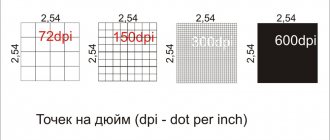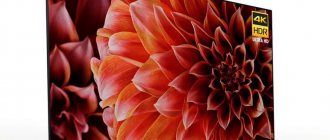What determines TV energy consumption?
The most important parameter is the size and type of screen: the larger it is, the higher the electricity consumption. A modern 43-inch LED TV consumes about 18 Wh when turned on. However, this is not the only factor. Among others:
- color;
- white balance;
- operating time included;
- operating time in sleep mode.
Users often forget that in standby mode the device also consumes electricity, but to a much lesser extent. On average, consumption is about 0.5 W/h. LED TVs have a modest electricity consumption, but older equipment with LCD or CRT panels consumes several times the above values.
How to save
To optimize the operation of your TV as much as possible, as well as reduce the number of kilowatts, you need to follow a few simple tips:
- Install the TV device in a room with even lighting. As a result, you will be able to choose the optimal balance between brightness and contrast. Therefore, the equipment will not move much.
- Brightness must be adjusted for different types of lighting. For example, in the dark you can reduce the brightness without losing comfort during viewing.
- As mentioned earlier, TVs also consume a fair amount of electricity in sleep mode. Therefore, it is better to unplug the equipment.
- Use Eco-functions wisely. Then you can spend a minimum amount of money on paying electricity bills.
Each of these recommendations reduces energy consumption on average per day. So try to stick to them to save on your electricity bills. This is especially true during a time of ever-increasing utility rates.
So we looked at the main factors influencing the amount of TV energy consumed. Each user will be able to quickly calculate the potential costs associated with paying electricity bills.
Energy efficiency class
Energy efficiency is an indicator of the ratio of the consumption of a particular model to average values. The approved standard for televisions was adopted in 2009 by a special commission of the European Union. Classes are marked with letters from “A+++” to “G”, where “A+++” is low consumption, “G” is maximum.
TV energy efficiency classes
It is important to understand that a certain class is not the same for different devices. In particular, for TVs with a diagonal of 32 and 40 inches, the values will be different.
The calculation takes into account, among other things, the screen size. In addition, the values are given for ideal conditions - with certain brightness and color settings and without connected peripherals, which can also increase consumption.
Previously, energy efficiency was indicated only in the instructions for the device, but in the Russian Federation a law was passed requiring special stickers to be placed on equipment indicating the energy efficiency class, annual consumption, name of the manufacturer, model, and the size of the TV.
Information sticker on the TV
European energy classification
The classification system agreed upon by the Energy Directive is based on the idea of reducing the energy load in the household activities of the population in order to save energy, as well as the rational use of energy resources.
In this video, they will tell you how energy efficiency indicators affect energy efficiency indicators!
Major household appliances such as refrigerators, washing machines, televisions and others should be energy efficient. The marking includes the letters of the Latin alphabet from A to G. The most economical device will be marked with the letter A.
Class A is divided into three more groups, which are designated by the letter A with one, two and three pluses. According to members of the European Commission, more than three becomes impractical.
In turn, as we strive to reduce energy consumption, the lower threshold will shift. Let’s say that devices of a certain brand will have maximum efficiency, the standards will also change.
The marketing move of members of the European Parliament also deserves attention. Devices labeled as energy efficient will be in great demand among the population. The labeling will be a kind of advertising and competing firms will strive to reduce the energy consumption of their products.
If we go back to the recent past, about ten years ago, when the first plasma and LCD TVs appeared, it is easy to notice the fact that the power of these models was greater than that of common TVs with cathode ray tubes (picture tubes) with relatively the same screen sizes.
Plasma TVs were especially energy-hungry. The plasma power with a diagonal of 40 inches reached 500 W. And yet, demand was created due to its fairly compact size.
Modern LCD (LED) TVs have the ability to regulate energy consumption. This can be achieved by adjusting the brightness of the screen backlight. If you watch TV in a dark place, you can turn off the backlight without losing visual comfort.
When purchasing a TV, you should check whether it has energy saving features. Modern TVs have a function for automatically adjusting backlight settings.
We also note that LED backlighting comes in two types: White LED and RGB LED. The first involves placing a matrix of LEDs around the perimeter, the second is placed behind the LED matrix and has the ability to illuminate different areas in different colors.
Power consumption of different types of TVs
RGB LED is considered more expensive due to the use of mercury in the fluorescent elements and produces a higher quality image than LED backlighting. It is thanks to LED backlighting that LCD TVs have surpassed plasma TVs in terms of energy efficiency.
According to experts, plasma TVs transmit colors with less distortion, while LCDs have better contrast and softer colors. For example, modern plasma TVs with a diagonal of 40 inches consume about 200 W, and LED TVs with the same diagonal consume 110-130 W.
In terms of service life, LCDs last approximately twice as long as plasma ones. But even with such a period, plasma can last up to 10 years.
It is also necessary to understand that a TV, be it an LED or a plasma panel with class A, will cost significantly more than, for example, a similar device with class C consumption. This is due to the use of more expensive materials, thermal insulation components, as well as the use of precious metals with high conductivity , such as gold, platinum.
Accordingly, class A models will be more durable and cheaper to operate. Thus, having paid a smaller amount for low quality, you will have to pay, subsequently, for the repair of equipment of a lower class.
Specialized accredited laboratories have been operating in Europe since 1992; they appeared in Russia in 2011.
How to find out the power consumption of a TV
Information about the energy consumption of a TV model can, of course, be found in the document that comes with it - the technical data sheet. Compilers usually provide information on how much the device consumes in its maximum power mode and during standby. If suddenly the instructions for the equipment are lost, then the necessary information can be found on the Internet; you just need to know exactly the model of your TV.
You can take your own measurements, but for this you need to have special tools on hand. The power of the TV will be shown by a wattmeter, which will determine this indicator almost instantly.
Calculations for different types of TVs may show that completely different figures will be consumed. Knowing this may well influence the decision to purchase a particular device model.
How to find out your TV's energy consumption
First of all, you should look at the technical data sheet of the device. Manufacturers provide information on how much electricity the model consumes at maximum load. This includes the active mode of operation with high contrast.
If the instructions are no longer at hand, but you want to know the electricity consumption of the TV, you can do the following:
- Purchase a special tool for measuring power - a wattmeter. It shows results instantly.
- Carry out a calculation using a formula that takes into account the type and technical characteristics of the device.
- Turn off all appliances in the house except the TV. Take a stopwatch. And measure how much the electricity meter turns up in a minute.
Advice. Many manufacturers duplicate their TV passports on the official website. All you need to do is enter the exact model name. You can recognize it by the plate attached to the back panel, or by a sticker located there.
Calculations for different types of TVs
The data in the bill for electricity consumption of a particular TV depends not only on the type of device itself, but also on its operating time. The average consumer spends about 5 hours a day on this, which adds up to 150 hours in a month. And then it remains to figure out which of the devices turns out to be the most “gluttonous”.
With cathode ray tube
Almost all of us grew up with such television receivers - these are bulky models that have a kinescope. They are unpretentious in operation, have a long service life, but cannot boast of energy savings, because their consumption is 60-100 W per hour. In a day the amount of at least 0.5 kW comes out, and in a month the figure will rise to 15. In standby mode (that is, around the clock), the figure in watts will be equal to 2-3 units. The result for the month is from 16 to 18 kW.
Plasma
Such panels will give you a super picture in terms of color rendering and saturation, but in terms of energy efficiency they are far from ideal. If we take different operating modes, we get 150–190 W/hour during operation and 0.5 W during standby. 24.36–28.86 kilowatts come out per month.
Liquid crystal
LCD TVs are much more economical compared to plasma. But the diagonal size is of great importance for the power of the TV, which should not be forgotten when choosing the size of the device.
- For readings up to 32 inches there will be approximately 40 to 55 watts per hour and only 1 watt in standby.
- A screen of approximately 49 inches will take 100–150 W/hour and up to 22.72 kW per month.
- The LED variety will take another 40% less thanks to the use of diodes in the backlight.
Thus, the LCD variety of TVs turns out to be the most profitable in terms of energy consumption . But you can save money by knowing other criteria.
How many watts does a TV consume per hour?
There are three main types of TVs, each of which has its own electricity consumption:
- Plasma.
- Liquid crystal.
- CRT.
For most users, the TV is turned on almost 24 hours a day, and it is never unplugged from the socket at all, remaining in standby mode. The operating time of a TV device in the house mainly depends on the employment of family members, their lifestyle, interests, specifics of work and many other factors. Therefore, when choosing a device, you should also take into account how much time it will have to be turned on.
You can measure the amount of electricity consumed by your TV at home using a wattmeter. It will instantly show the power that is required to operate your TV. A wattmeter powered from an outlet is best suited for this procedure. He is able not only to take measurements, but also, when entering the cost of one kilowatt, to calculate how much it costs to consume such an amount of electricity in rubles.
You can also look at the device’s passport - it usually indicates how much electricity it consumes during operation and when it is in standby mode.
How much does plasma TV consume?
Plasma TVs are considered one of the best in terms of technical characteristics and service life. They have the ability to transmit high-quality images and clear sound transmission. This TV is lightweight and, due to its small thickness, does not take up much space in the room. At the same time, plasma consumes quite a lot of electricity. For example, a device with a 42-inch diagonal requires about 170 W/hour. If you make a monthly calculation, then, on average, it turns out that maintaining such a device at home will require about 25 kW.
How much does LCD TV consume?
Liquid-crystal TV models today are already considered obsolete - plasma is too actively pushing them out of the market. However, from the point of view of energy intensity, these models are not so bad - they require an order of magnitude less electricity to operate. For example, a device with a 32-inch diagonal requires approximately 50 W/hour and 8 kW per month to operate.
A type of LCD TV - LED panels consume electricity even more economically - its consumption, on average, is 40% less than that required by an LCD device. In standby mode, such TVs require 0.3 watts of electricity per day, and during operation, with a 49-inch screen diagonal, 120 watts per hour. Thus, such a device will consume about 20 kW per month.
Consumption of cathode ray tube TV
The energy consumption for a TV with a picture tube, which has already served its owner for quite a long time, is about 80 W/hour. In one day of operation, such a device can “eat up” about half a kilowatt of electricity, and in a month – 15 kW. Such models were the very first video broadcasting devices to appear on the market. Our great-grandmothers and great-grandfathers watched them. At that time, no one thought about how to reduce the electricity consumption of a TV; the fact of the appearance of a device capable of transmitting pictures and sound was so important.
How to save money when using a TV
It was mentioned above that modern LED-backlit TVs consume a small amount of energy, but older equipment cannot boast of the same. In this case, recommendations for saving it will help.
- Placing the TV in an evenly lit room will save on lighting costs. But here it is worth considering that too bright light makes the screen dim, which means that in order to see the picture, you will have to increase the brightness of the backlight.
- In standby mode, the TV continues to consume energy. LED TV has minimal indicators, but plasma can consume up to 5 W/h. In this case, unplugging will save money.
- Any TV has an economy mode - it can be set in the picture settings. The picture turns out less juicy and bright, but consumption with this display is also lower.
- Often users fall asleep in front of the TV in the evening, and it continues to work all night. Modern models have a timer or shutdown function after a certain period of inactivity, for example, if the user is inactive, the screen will turn off after 4 hours. It is worth knowing about such options and using them.
- Some TVs may have a presence sensor. Thanks to it, the device understands whether there is a person in the room, and if there are no spectators, it goes into standby mode.
- When choosing a TV, among other parameters, you should take into account the energy efficiency class. As mentioned above, the minimum is “A”, but “A” with a few pluses is better.
- Peripheral equipment that connects only to USB connectors receives power from the TV. If the hard drive or smart device is not needed at the moment, then you should not keep them connected.
The constant rise in prices for utilities has made the issue of saving resources, including electricity, urgent. Many of us have televisions on 24/7, and some families have several such devices. Knowing the consumption of your TV device model will allow you not to be puzzled by the number of digits in the final bill of the receipt.
How to determine the power of a TV in watts
Most often, the documentation that comes with the TV indicates all the information about the purchased device, including the number of kilowatts consumed. However, in practice it may turn out that the TV actually consumes a large amount of energy.
Wattmeter
Thanks to this device, which has a fairly large number of available functions, all measurement work can be simplified. This device can incredibly quickly calculate the maximum accurate amount of energy consumption of devices in all states.
Voltmeter and ammeter
If the user has at least basic knowledge about the operation of household appliances, and also has an ammeter and a voltmeter in his home, then he will be able to very quickly, with maximum accuracy, find out the amount of energy expended without any problems.
This is done as follows:
- First, you need to use a voltmeter to measure the network voltage level, and then take these readings;
- Afterwards, in the circuit located next to the input to the device, the user must connect an ammeter. The obtained indicators must also be taken;
- The results obtained after taking readings from two instruments must be multiplied. The result should be the power supply.
Thanks to this method, each user can very quickly find out, with an accuracy of hundredths, how much is consumed by the device during operation.
Apartment meter
In order to perform this method, it is not necessary to have special knowledge. All you need to do is look at the readings on the meter, and then do some mathematical calculations. This is done as follows:
- First, the user must turn off all appliances in the house that may consume electrical energy for the duration of the work;
- Next, you need to look at the initial readings on the meter and write them down on a piece of paper. Afterwards you can turn on the TV;
- You will need to wait one hour, and then write down the meter readings again;
- In the end, to calculate energy consumption, you simply need to subtract the old ones from the new indicators. The result should be the energy consumed per hour of TV operation.
Also, the user can find out the price of electricity by multiplying one watt by the official cost of electricity consumption in the region.
How to find out the power consumption of a TV
There are several accepted energy efficiency standards for televisions. They are calculated as the ratio of power consumption at peak, with maximum brightness, sound, working adapters, to the display area. The resulting index is accepted as an indicator of energy efficiency. For class G devices it is 100 or less. For the most modern Samsung or LG devices that meet the A++ standard, the index value is below 16.
However, the TV consumes very little power in standby mode. And when working with Internet resources, at full volume it wastes quite a lot of it. At the same time, the indicator “average TV power” simply does not exist. How to determine how much a particular model uses kilowatts per month?
Manufacturers relieve buyers of all the complexities of calculations. Each TV has a sticker indicating compliance with a particular energy efficiency standard . It is also given in the operating instructions for the model. It states (from top to bottom):
- brand name and TV model marking;
- energy efficiency class and general scale of existing standards;
- the footer of the sticker, its lower part, introduces the user to the diagonal of the display, the size is given in centimeters and inches;
- the small square above the screen diagonal indication area shows the average hourly electricity consumption in watts in operating mode;
- in a large square, the average electricity consumption in kW per month of operation.
Important!
The last indicator is the most interesting for the user. It describes how much power the TV consumes under certain conditions. This is the average display brightness and acoustic volume, the wireless communication adapter is disabled, work for 4 hours a day. It is worth especially noting that the calculation of monthly energy consumption does not take into account how much electricity the TV will burn in standby mode. Although the power consumption during idle time is small, in terms of annual calculations it adds up to a fairly high amount.











